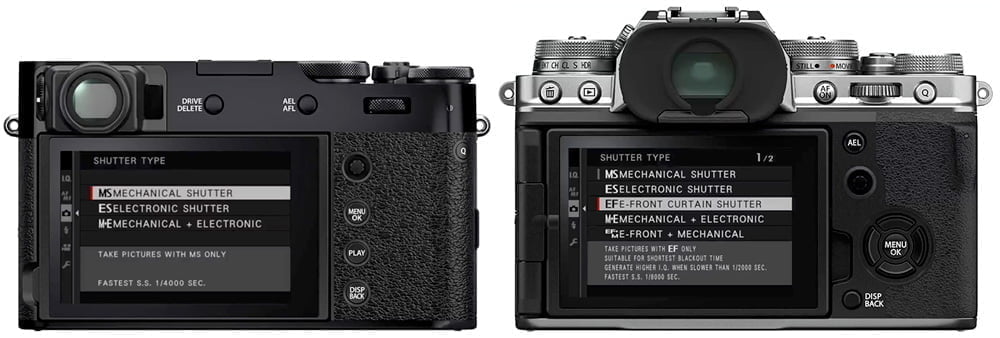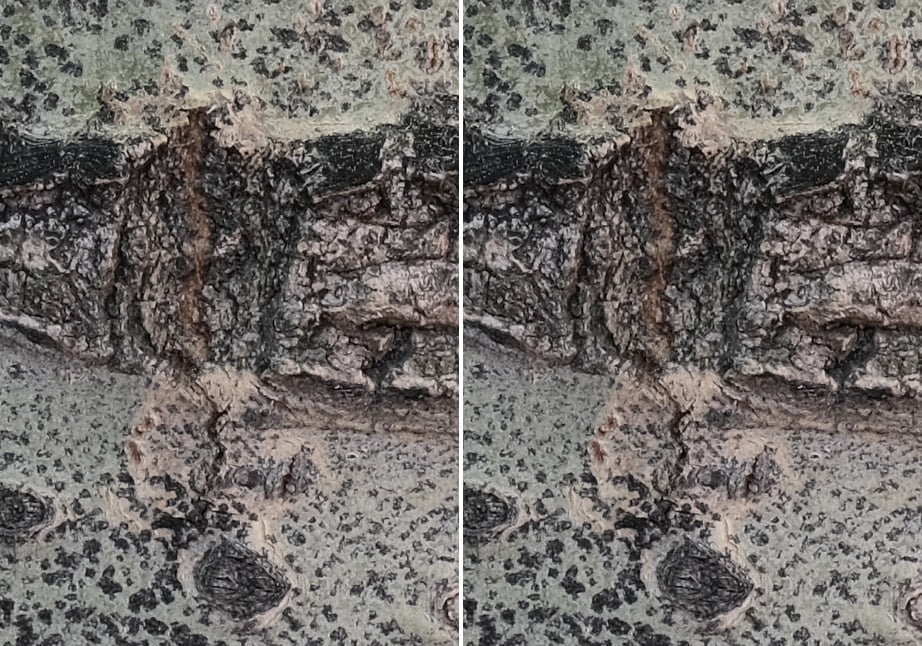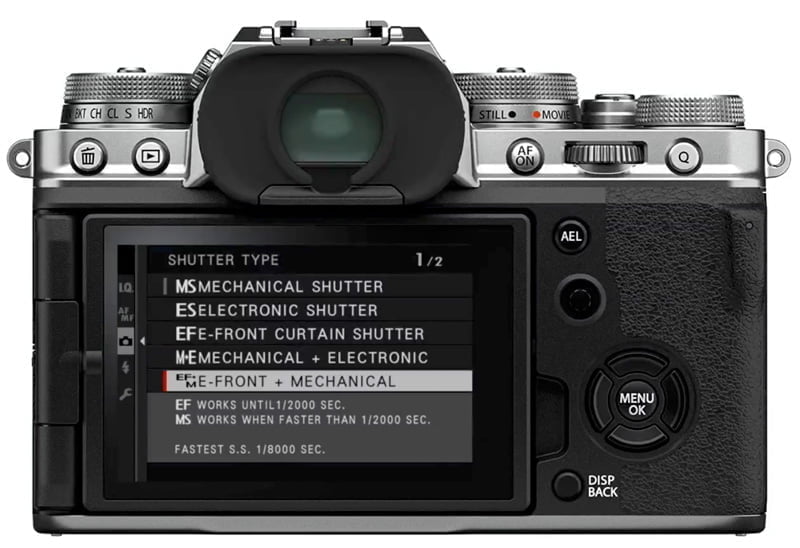Disclosure: This post may contain affiliate links. I earn a small commission of product sales to keep this website going.
Most mirrorless cameras have at least two types of shutters. Those things that start and stop the sensor recording the light that comes through the lens.
There’s the traditional mechanical shutter and an electronic shutter. But some cameras also have an “electronic front curtain shutter.” This type of shutter may be enigmatic to many photographers, so we’ll take a look at the basics here.
This post will be based on Fujifilm’s Electronic Front Curtain Shutter, but the principles will mostly apply to all camera brands featuring this shutter type.
Does your camera have Electronic Front Curtain Shutter?
Several newer Fujifilm interchangeable-lens cameras include an electronic front curtain shutter.
If you press MENU/OK then go into the SHOOTING SETTING menu, look for “SHUTTER TYPE”. You’ll see several options when you go into SHUTTER TYPE. You’re looking for “EF”, or “E-FRONT CURTAIN SHUTTER.”

If you don’t see this in your shutter type menu…sorry! You can continue reading this article if you want but you won’t have it in your camera 🙂 As of this writing, Fujifilm cameras that do have this feature are the X-T3, X-T4, X-Pro3, X-H1, and GFX cameras.
Reference your camera manual for other camera brands.
What is the difference between Electronic Front Curtain Shutter, Mechanical Shutter, and Electronic Shutter?
It’s easier to understand what the Electronic Front Curtain Shutter does if we first understand the other two shutter types.
Mechanical Shutter
Let’s start with the traditional mechanical shutter. There’s a thin piece of metal in front of the sensor, blocking the light from reaching the sensor just prior to the exposure.
When you press the shutter button and the exposure begins, that first, or front curtain opens to reveal the sensor to the light. It’s followed by a second, or rear curtain to end the exposure. The difference between the two is your shutter speed. If your shutter speed is 1/50 sec., that second curtain will start closing 1/50th of a second after the first curtain started to open.

Now there are a few things to note here because this is mechanical:
- There is a very slight lag to get that front curtain moving when you press the shutter button (measured in milliseconds).
- The moving parts produce a little bit of noise, which may be unwanted in certain situations.
- Those moving parts can also “bump” the sensor in the beginning of the exposure. This is called “shutter shock” and in some cases may ever so slightly reduce sharpness. This might be visible when using telephoto lenses and when using shutter speeds between around 1/2 to 1/50 sec. (longer exposures “cancel out” this initial movement and faster shutter speeds don’t give it a chance to affect the photo).
With all of that said, a great deal of the most memorable photos in human history were created with mechanical shutters, so don’t sweat it too much. This is really nitpicky stuff. The kinds of things that a lot of Internet photography forum visitors unnecessarily lose sleep over.
Electronic Shutter
The electronic shutter is included to address some of the concerns above.
When using the electronic shutter, those curtains are fixed open during the exposure. The sensor is exposed to the light before and after you press the shutter button. But an electrical signal prevents the sensor from recording that light.
When you press the shutter button, the camera sends a signal to the sensor to start “reading” the light from every pixel on that sensor. It reads that light for however long your shutter speed is. Then it’s done reading.
However, we’re dealing with massive amounts of data here. For now, our cameras can’t read every pixel simultaneously.
It will read the top line of pixels on the sensor then move to the next line. And then the next, and so on, until it reaches the final line of pixels.

Even though your shutter speed may be a speedy 1/4000 sec., it will actually take longer than that for the processor to read every line of pixels on the sensor. It may take longer than half a second to read all of the pixels using the electronic shutter in GFX medium-format cameras. It can take anywhere from 1/100th to 1/10th of a second in APS-C cameras.
You can imagine the complications that will introduce, especially if you’re holding the camera by hand and moving around really fast. Or your subject is moving.
I have an entire article dedicated to the disadvantages of the Electronic Shutter, which you can read here.
Electronic Front Curtain Shutter
Enter the electronic front curtain shutter.
Now that you know what both mechanical and electronic shutters are, can you take a crack at what electronic front curtain means?
Think about it.
Ok so here’s the answer.
The front curtain is already open prior to the beginning of the exposure, just like the electronic shutter. That sensor is exposed to light but it’s not recording any of it.
The sensor will start recording the light when you press the shutter button. But instead of controlling the length of the exposure electronically, it’s controlled mechanically through the closing of the mechanical rear curtain.
It’s a complex coordination between the electronic and mechanical mechanisms. It’s an attempt to be a “best of both worlds” answer.
Pros & Cons of the Electronic Front Curtain Shutter
Advantages
Because the front curtain is already open – nothing is moving at the start of the exposure – you’re not risking that “shutter shock” that might add a little bit of blur to the photo. The moving parts come over the sensor to end the exposure, not start it.
Again, this is something that you might notice only if you’re pixel-peeping. And only during the conditions mentioned above; when using a telephoto lens with shutter speeds between around 1/2 to 1/50 sec.
The photo below is a comparison of some tree bark taken with an X-T4, 140mm focal length, ISO 320, f/11, 1/10th sec., JPEG out of the camera. The image on the left is using the Mechanical Shutter and the image on the right is using the Electronic Front Curtain Shutter. After resizing, compression, uploading, and displaying on your monitor, I doubt you’ll notice a difference. And that’s the point. I could barely notice a difference (but I did see one) studying every individual pixel in the RAW file. So it’s there. Will your viewers see it?

Since the front curtain is already open, another little advantage is that there’s less lag between when you press the shutter button and when the exposure begins. No mass to get moving first. We’re talking milliseconds (if not nanoseconds) here, but hey, sometimes that can make the difference. This also results in a slightly quieter exposure, though not 100% silent.
Disadvantages
You can’t – or shouldn’t – always use an electronic front curtain shutter though.
Without going too deep into the weeds here, there is a disparity between how fast an electronic exposure can be made and how fast that rear curtain can move. This can create some problems, particularly when using very fast shutter speeds. These problems include uneven exposures, “cut” bokeh, banding, and more.
Fujifilm has our backs though. They can limit the use of this shutter type to 1/2000 sec.; anything faster, and the camera will switch to the mechanical shutter. I’m not going to name any names, but some camera brands (cough, Sony, cough) don’t have this limitation in place. This leaves photographers scratching their head as to why their exposures are so far off when the e-Front Curtain Shutter is set ON.
When to use Electronic Front Curtain Shutter
Decisions! When do you use Mechanical, Electronic, or Electronic Front Curtain Shutter?
It’s no secret that I’m a caveman. I just want one thing that I can hang my hat on. You can find entire flowcharts depicting how to choose a shutter type based on what you’re shooting, your shutter speed, your aperture, etc.
Being a documentary photographer, my shutter speed, aperture, light source, focal length, subject movement – everything – is all over the place from one shot to the next. There’s no way I’m switching shutter types between every photo.
It’s for this reason that I set my shutter type to “EF+M”, or “E-FRONT+MECHANICAL” for 99% of the time. This has worked well for me.

In this mode, the camera will use the Electronic Front Curtain Shutter as a default until your shutter speed approaches 1/2000 sec. The camera switches to the Mechanical Shutter as your shutter speed goes faster than 1/2000 sec., like if you open up your aperture for a sunny portrait or to capture some fast action.
However, up to 1/2000 sec., you still get the benefits of the Electronic Front Curtain Shutter. The sharpest photos possible in situations where shutter shock might be a factor, a quieter presence since only one curtain is moving instead of two, and a slightly faster capture when you hit the button. Even though the only documentation I’ve found says flash is unavailable in this mode, I’ve still been able to use flash when needed.
If you’re just going to set the camera to “EF”, watch your shutter speed and make sure it doesn’t go too fast, like over 1/2000 sec. If you do need these fast shutter speeds, use either the MS or ES.
What do you photograph?
But you may not be this type of photographer.
You might strictly work in a studio environment with controlled lighting. I’d recommend just using the Mechanical Shutter in this case.
Or you may be a still-life photographer (like landscapes) who does worry about shutter shock, but nothing is moving in your scene, and you want to be quiet. I’d probably just go with the Electronic Shutter in that genre.
No matter what you photograph, having an understanding of the different shutter types can help you capture better photos.

David Hampson
Wednesday 30th of June 2021
Nice piece, John. It'll be interesting to see which manufacturer comes out with a consumer grade global shutter first.
John Peltier
Wednesday 30th of June 2021
My money is on Sony. They already came out with a large format global shutter earlier this year, and they make sensors for other cameras (like Fujifilm), so we'll see when it's available to us normal people!